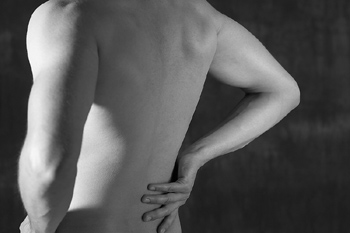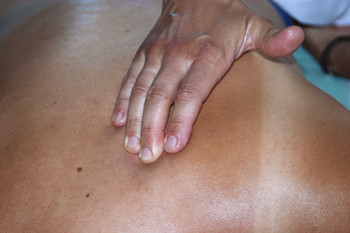Stay Informed
Popular Articles
- Hiatal Hernia: Hidden Cause of Chronic Illness
- Small Intestinal Bacterial Overgrowth (SIBO)
- Applied Lymphology: Unlocking the Secret to Pain Relief
- An Introduction to Constitutional Iridology
- The Low Down on Liver Detoxification
- An Energetic and Emotional Approach to Cancer
- Fat Facts
- Marrow in the Bones
- Blood Type and Nutrition
- Cardiac Herbs: Beyond Hawthorn
Quick Search
The School of Modern Herbal Medicine




Why Massage Relieves Pain
- 4/8/2009
- Categorized in: General Health
This is page 3 of a four-part article.
 So, let's look at another instinctive reaction to pain. Most of us have probably “overdone it” on occasion and wound up feeling stiff and sore the next day. During unusually strenuous exercise we cause physical and chemical damage to our muscle tissues. As a result, the process of inflammation occurs and we experience pain in those muscles. Again, the cells are crying for oxygen.
So, let's look at another instinctive reaction to pain. Most of us have probably “overdone it” on occasion and wound up feeling stiff and sore the next day. During unusually strenuous exercise we cause physical and chemical damage to our muscle tissues. As a result, the process of inflammation occurs and we experience pain in those muscles. Again, the cells are crying for oxygen.
So, what we instinctively do is start rubbing those sore muscles. We do this because we know it makes them feel better. Again, our instincts are right on track.
You have probably noticed that sore muscles feel tense and slightly swollen. Of course, this is caused by the fluids built up in the muscle tissues. When we start rubbing the sore muscles, we are increasing lymphatic movement because the pressure and stroking actions increase lymphatic flow. This helps drain the excess fluid away from the muscles, increasing the supply of fresh, oxygen- and nutrient-laden fluid from the blood.
So massage is our next pain relief technique. But, like the pressure technique, it doesn't work if you quit too soon. When you notice a pain and start instinctively rubbing, stick with it. When pain is chronic, those stagnant pools have been there for a long time and a lot of “garbage” has accumulated in them. You can't drain all of that away at once as those toxins will irritate other tissues and cause more inflammation. You have to release them gradually over a period of time and help your kidneys and sweat glands flush them out. That's why you should always drink lots of water after a good massage.
The Light-Fast-Stroke
But even massage isn't always practical. So, another technique that can be very helpful is rapid light stroking. Dr. West called this technique, the Light-Fast-Stroke. This technique is very valuable because it can be done over a large area of the body, such as an arm or leg. All you need to do is brush very lightly across the surface of the skin using a rapid back and forth motion.
This technique works because it also moves lymph. In a presentation at the International Society of Lymphology convention held at Montreal, Canada in 1981, Dr. W.L. Olszewski presented the research demonstrating that this rapid, light stroking technique dramatically increases lymphatic movement.
I remember one time when one of my children had an injury to a portion of the thigh. There was a big, red welt on the leg, the kind that normally turns into a large black bruise. However, I told the child we were going to “rub the bump away” and proceeded to use the light-fast-stroke technique. After a couple of minutes the red welt started to receed at the edges and in a matter of about five to ten minutes it was completely gone with no bruise.
Now, here's another little secret. The light fast stroke works even if you don't actually touch the skin. I've done the light-fast-stroke over the surface of an injured area about one to one and a half inches above the surface of the skin and it still created a relief of pain. For example, I once did this on a girl who was very badly sunburned on her arms and shoulders. The sunburn was so bad that she was swollen and blistered. After about ten to fifteen minutes of light-fast-stroking above the surface of her arms, I was able to lightly massage aloe vera gel all over her arms and within one-half hour, there was no pain and no swelling in either arm.
Energy and Pain Relief
So, how does that work? Obviously, it isn't taking place from compression of the lymphatic tissues. It has to do with the electromagnetic fields that keep the proteins from clumping together and creating stagnant pools. The rapid stroking increases the electro-magnetic energy over that area, which causes the proteins to break up and allows them to move into the lymphatic system, thereby draining the excess fluid away from the site of injury.
Fredrick Plogg, M.D., who has worked with lymphatics in Germany, maintains that the diminished electrical effect is what causes the blood proteins to cluster together in the tissue spaces, making it difficult for them to be removed by the lymphatic system. He indicates further that the application of energy—any energy for that matter—into the clustered plasma proteins will cause them to break up, making them easier for the lymphatics to move.
This helps to explain why, in many instances, just placing your hand on or over a painful area seems to help in relieving pain. In doing this, there is no mechanical action, no massaging and no pressure, so the action does not pump the lymphatics. However, from experience we know that it does assist in returning the tissues to the “dry state,” which relieves pain.
